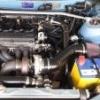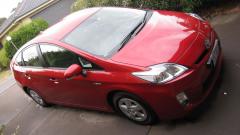-
Posts
18 -
Joined
-
Last visited
-
Days Won
1
Braddles last won the day on April 24 2015
Braddles had the most liked content!
About Braddles
- Birthday 08/29/1969
Profile Information
-
Gender*
Male
-
Toyota Model
Prius
-
Toyota Year
2009
-
Location
Australian Capital Territory
-
How did you find us?
Google
-
Interests
Classic Cars
Car Modification
Computers & Electronics
Contact Methods
-
First Name
Bradley
Recent Profile Visitors
39,710 profile views
Braddles's Achievements
-

How to check if a safety recall was completed for a used car
Braddles replied to Daviid's topic in Prius Club
Any Toyota service department should be able to confirm by checking against the VIN. Here are the recalls for Toyota http://www.recalls.gov.au/content/index.phtml/itemId/952857 You haven't said which series you own. 2009 covers the change from NHW20 aka Gen II aka 2004-2009 model to the ZVW30 aka Gen III aka 2010 model from May 2009. (The 2012 facelift is still the ZVW30.) The NHW20 had two recalls in November 2012. The ZVW30 had a recall in February 2010. -
The ride quality of the Prius 30 is on a par with most small/medium cars. I can't speak fit the Prius C because I can't fit in it (I'm 195cm). Battery life is not worth worrying about. Unless you will be driving in severe, sub-sub-zero or extreme heat, the battery will take care of itself. If you flog it, it will still return reasonable fuel economy. If you learn hypermiling techniques and learn about the machine, you'll get the ADR figures in most conditions. It is possible to get better fuel economy from the Prius C in city conditions but the Prius 30 is better if you drive at highway speeds regularly. Prius C might be better in Sydney but the Prius 30 would be better in Canberra. Here's some comparisons of Prii with real-world conditions, not artificial tests. BTW, The Prius 30 is known as the 2010 Prius on US sites. http://www.fuelly.com/car/toyota/prius Prius C http://www.fuelly.com/car/toyota/prius%20c As for my fuel consumption... My current tank in my Prius 30 has taken me 1101km and will last about 60km more for a 700 mile tanks. I use a number of techniques to get there, but otherwise I drive to normal places at normal speeds with normal stuff in my car. (Hint: the Distance to Empty calculation in the Prius 30 is ridiculously conservative, triggering panic when you still have 10 litres left.)
- 1 reply
-
- 1
-

-
1. Is the Prius any good? Very good. While the price reflects the cost of the hybrid gubbins, there's plenty of other technology that you won't find on any car that side of $50,000. (The argument that you won't save enough money from petrol savings to make up the difference is silly. You won't save money driving a Lexus, so just buy a Chery instead.) It is a "fun" car. not as in "sideways", "loud" or "sporty" but as in "video game". It has good interior space and will take a surprising amount of luggage. 2. Is it any good as a family car as my wife will be using this car along with our 6-month old baby girl. I've had 2 children on boosters and an adult in the back with adequate space As long as the Hybrid battery vent on the left rear is not blocked by a bum or a blanket, there's enough room. 3. Is servicing expensive? I have a Toyota extended warranty that includes some deal on service costs. Major service at 80,000km was $650 90,000km service was $185 Much cheaper than my previous 2 European cars 4. One of the cars i've been looking at on carsales.com.au stats that it has manufacturers warranty until 2013. Would this cover the battery Yes. Toyota extended battery warranty on all cars (not just new) to 8 years/150,000km. 5. How much would it cost to replace the battery? The 12 volt battery is about $220. It is a special design and there's not many substitutes from the GS Yuasa original in Australia. The hybrid battery is about $2700. 6. What kind of regular maintenance if any does the battery/car need? topping up oil? water? coolant? etc. There's an extra radiator for the inverter coolant. Otherwise, the same as any other car. 7. Can you put custom rims on the car? ;-) In the Gen III (May 2009 to present) the PCD is 5 x 100 with 43 inset for the 15" and 50 inset for 17" However, going wide will reduce fuel economy The original wheels and wheel covers are aerodynamic. There is a surprising amount of lift and drag if you choose the wrong wheels. The biggest I've seen is 20" with 225/30/ tyres on Japanese customs. Bonkers. There are 20" with 215 tyres, which is the same width as OEM 17" tyres I reckon that 16" with 205/55 tyres is a good compromise size for a small car. A spiffy set of BBS "eco car" wheels could save 4-5kg per corner. 8. How does it handle highway/freeway driving The Gen II with the 1.5l engine works fairly hard at 110km/h. It's highway fuel consumption can be greater than city The Gen III with the 1.8l engine is more fuel efficient than the Gen II because it has a much wider "sweet spot" and can rev less to do the same work. And because of regenerative braking, cruise control will maintain your speed going down a steep hills while charging the battery. 9. Should i avoid 2007 -2008 model Prius for any particular reason? They are still very good. The Gen III is better. 10. Finally what should i be looking out for when purchasing a second hand prius As with any car, full service history. Look for regular intervals by date or distance. Get verification that all service advisories have been applied. As with any car, there have been recall notices and any Toyota dealer will be able to verify.
-
That's great news, whatever the font. Were you able to assess the condition of the battery from the wreckers? Does it drive as good as new?
-

AUSTRALIAS FIRST PRIUS - 11 years 300,000km Lives Again!
Braddles replied to ArnoldE's topic in Prius Club
That's great news. However, I demand to see photos! :D If I'm lucky I'll be helping to refurbish a NVW11 Prius early next year. I suspect that we'll be enhancing it somehow. -
Hi Subbu Maybe you should post against Dolce_Vita's thread, since it is about buying a Prius. I would agree with Dolce_Vita's answers, however the price of servicing is a little higher (inflation) and the price of a replacement HV battery is a little lower. Here's a few things to consider: Since that post, Toyota Australia has released the NVW30 Prius (Gen III), the Toyota Camry Hybrid, the Prius C and the Prius V and you could include the Lexus CT on that list. So you can now choose from a compact hatch, a medium-sized hatch, a sedan and a 7-seater wagon. You say that you have a 2009 Prius. Is it the same model as the photos above (2004-2009 Gen II) or is it the later model Gen III?
-
Check with Toyota to see if they can supply one; see how much and see what warranty they will put on it. HV batteries in current cars come with a combined 8 year, 160,000km warranty in part because they are so reliable. Then see if they would fit a HV battery from a wreck where the vendor is offering 3 month warranty. Any pictures?
-
Welcome ArnoldE That's one special car. You should see what Toyota would be interested in doing with the car, given its historical significance. Have you been using the car regularly, recently? Can you determine the cause or extent of the failure? I don't know the price of a replacement battery for a Gen1, but $3,000 is the quoted amount for Gen2 and Gen3. You closest you can get to battery repack in Australia is probably NilCO2. Contact www.NilCO2.com.au as they fit batteries to create Plug-in Prii. If they don't repack, then you could remove your HV battery and replace it with a much larger unit and get a long EV range. It would cost much more than $3,000, but you would get much more than 1-2km of range; more like 40km. Possibly. I don't know if they fit Gen1, however. There are more options in the USA including http://www.re-involt.com/ who can rebuild the battery for less than $2000. Let us know what happens. :)
-
I just fitted a DEFA engine block heater to my NVW30 Prius. DEFA is a Norwegian company that makes a huge range of engine block heaters. Their distributors are Waeco-Dometic, but not in Australia where Waeco is better known for cooling than heating. Waeco would need to certify it against Australian electric standards, which isn't economic for the number (1) they are likely to sell. No such restriction on self-importation. DEFA doesn't sell them, but Bjørn was very helpful and answered enquires very quickly. I had to find a on-line retailer from Europe. I stumbled onto www.CARandCAMP.de but there's plenty throughout Europe. BTW, you don't pay the VAT since it is an export from EU. Cost $280, including postage from Germany. Considering how much kit you get and how well made and resolved it is, it's worth every Euro. You'll pay at least that much for a Toyota EBH from Canada + 110v-240v step-up transformer what enough grunt to run it. [Once I thought it through] easy to fit from underneath the car. No special tools needed, but you will need a CEE 7/7 plug to AS/NZS 3112 adapter for the power cable. Works. I haven't quantified the cost/benefit; I would need to log every data point from a large number of runs. However, switching on for even 20 minutes can help a cold engine. Maximum time is about 3 hours, after which you won't get more heat into the engine. And if you are considering a plug-in battery conversion, an EBH might stop the engine from running at all for even bigger savings. Full details and pix on my blog: Part 1, Part 2 and Part 3.
-
I'm in the same boat. The right corner of the bumper was pushed in and popped out again by car park faeries. The damage isn't great and I have coverage for little dings, so I can get it fixed quite cheaply. I initial hope was that I could fit a body kit instead of fixing the bumper... but of course the body kit would only cover the bottom of the bumper and not replace the whole thing. Get the repair assessed, because it may be possible to fix it. As for fitting a reversing camera, check Toyota Manuals here and search for "Rear View camera". The installation instructions assume wiring to the factory sat nav, but at least you'll see the pins and wiring that you need splice to. (You'll probably want to get a wireless camera and screen after reading that!) You'll need good stiff plastic levers to prise panels; I use a Kincrome set. The pins are quite stiff and need a bit of force to remove. Take care and work methodically. You should be able to find replacement pins at AutoSuperRepco if you break any.
-
Midnight, here's the complete list of cars, in English: http://www.trdparts.jp/english/list_car_index.html You'll notice that there's a lot more than Aurion and HiLux. I have Japanese brochures for the Prius alpha (Prius V NVW40 when it goes on sale here) with 10 pages of accessories, including 6 different Navigation units to choose from, but no TRD parts for the NVW40 or NVW41. Yes, TRD in Japan is not the same as TRD in Australia.
-
The TRD parts for Toyota's large range of hybrid vehicles would tend to improve their fuel economy. Changing bulbs for LED reduces drain from the 12v battery, lowering the car reduces drag, etc. all of which saves petrol. On the other hand, changing wheels might not help if weight reduction is offset by increased drag from wider tyres and spoke pattern. http://www.trdparts.jp/english/list_aqua.html TRD parts for non-hybrids may include parts specifically designed to increase performance and therefore almost certainly increase fuel consumption. Just think if you could order TRD parts for any Toyota instead of the paltry range of accessories sold here. You can Even buy TRD parts for the AE86, all the way to a new racing engine.
-
Hybrid taxis have a few big advantages over LPG and Diesel taxis: The Prius can manoeuvre for up to 1 km on battery alone. That's while running the A/C and lights so maybe a bit less if the radio, dispatch system, EFTPOS terminal and other accessories are taken into account. Regenerative braking extends the life of brake rotors since the brake pads only touch the discs when applied hard. Over 200,000km before replacement is not unusual. Engine either runs at high load and therefore efficiently or not at all and therefore even more efficiently. The Falcon, Camry (non-hybrid) and Skoda Superb have a big advantage in payload over the hybrid Camry and Prius. But as for interior space, speaking for my 195cm I can tell you that a Falcon taxi doesn't have the headroom of my Prius. Maybe it's the beaded seat cover? In Kyoto last year I saw a taxi rank outside the Takashimiya department store exclusively for EV and PHEV taxis. I was wlaking everywhere so I didn't take one but it was great to see.
-
Hi Dolce Vita The original Engine Block Heater for the Prius is from Toyota Canada. AFAIK it is fitted to all Toyota Hybrids in Canada and perhaps even to all Toyotas. I asked a Toyota spare parts guy in Canberra about the EBH. As it happened he had lived in Canada and he immediately understood why it would be a good idea for a Prius in alpine areas of Australia. He also confirmed that Australia doesn't get them. The EBH is about the size of a cigarette lighter. There is a hole in the block into which the EBH fits snugly. It warms the block and the transmission. (I've since discovered that emergency vehicles in Canberra have coolant heater pumps plugged in to keep standby engines at or near operating temperature for a fast getaway. I'll try to find the supplier.) There is a very good reason to pre-heat the engine as is changes the start-up mode that the Prius uses. In summary, if the engine temperature is sufficient, it will not try to start until you demand it. You want to reach Stage 4 ASAP. Gen3 Prius ICE operational temperature stage legend ================================================== Stage S0: 12 seconds, no EV mode Stage S1a: 50 seconds, coolant < 40°C, no EV mode Stage S1b: coolant <(40°C) or (50°C) or < (65°C), no EV mode Stage 2: 40C < Coolant < (70C), EV mode < 16 km/h Stage 3(Normal): coolant > (70C), EV mode < 40km/h, partial glide Stage 4: coolant > 60°C, EV mode < 40 km/h, auto-stop on, full glide ================================================== BTW, "glide" refers to "pulse and glide", a hyper-miling technique that is very effective in the Prius. So if you live in a flat area or at the top of the slope, you will be able to drive for some distance effectively in EV mode before the engine needs to start. However, if you live at the bottom of that slope, the petrol engine will need to start soon anyway. In that case, if you live in a cold area, pre-heating the engine and transmission can have its benefits too as wear and fuel consumption will be reduced. If you live on a highway on-ramp, you'll be up to speed much quicker and should see a big improvement in fuel economy. As for energy use, 2-3 hours seems to be the optimal time from even the lowest ambient temperatures. A 400W EBH for 3 hours is 1.2kWh or about 20 cents depending on tariff. And If your timer is set to off-peak, it might be even less. If I find out more, I'll PM you. In the meantime, here's a thread from PriusChat of an upcoming EBH experiment.







